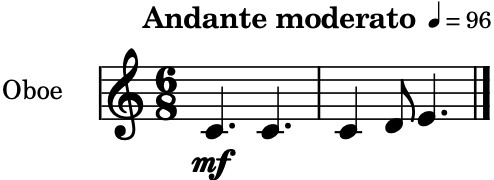Contents
1. Transposing music.
2. Speed of performance.
3. The notes of a scale and intervals.
4. Chords and Broken Chords.
5. Accents.
6. Repeat Marks and Jumps.
1. Transposing music.
Whilst the piano or violin always plays the note written in the music many popular instruments sound a different pitch to the one written.
For example, when a trumpet plays a written middle C the note that sounds is the B flat one tone below, and, if an alto saxophone plays a written middle C it actually sounds the E flat below
This is because the instrument’s tone is most beautiful or expressive dependent of a certain shape and length of the piping. (A trumpet built to play C as an open or unfingered note does not have the richness of tone of a B flat trumpet, which piping is just a little longer)
In this example the Oboe as always plays in concert pitch, The French Horn in F, the Trumpet in B flat and the Alto Saxophone in E flat, Listen to the sounds when they read the same music.

To compensate for the different pitch or sound, the music writer adjusts or transposes the music for the performer.
If the composer wishes the Oboe and the French horn both to play a middle C He has the write a middle C for the Oboe and an F for the French Horn.
In this example the Oboe as always plays in concert pitch, The French Horn in F, the Trumpet in B flat and the Alto Saxophone in E flat. Listen to the sounds now that there music has been transposed.
You will also see that the French Horn, Trumpet and Alto Saxophone parts now also Key Signatures as they are now playing in the keys of F, B flat and E flat respectfully

This is a list of common transposing instruments,
| English Horn | F |
| French Horn | F |
| Clarinet | B Flat |
| Cornet | B Flat |
| Tenor Saxophone | B Flat |
| Trumpet | B Flat |
| Alto Saxophone | E flat |
| Baritone Saxophone | E flat |
| Tenor Horn | E flat |
Additional transposing instruments
Sometimes the range of notes of an instrument would make it difficult to read the music, so the music is transposed an octave or even more to help the performer.
For Example
| Double Bass | Up an octave |
| Glockenspiel | Down two octaves |
| Guitar | Up an octave |
| Piccolo | Down an octave |
| Soprano or Descant Recorder | Down an octave |
| xylophone | Down an octave |
Note. It is important to understand transposition of music as this subject is a regular part of music theory exams
2. Speed of performance.
So that we know how fast to play a piece of music the writer puts a tempo mark above the top stave at the beginning. Often composers use a note with a number indicating the beats per minute.

If it is required to change tempo or speed during a piece another tempo mark will be placed above the stave.
Here is a List of speed instructions that may be placed on the music above the clef to instruct the performer how fast to play the music.
Common tempo markings from slowest to fastest:
| Name | Description | Speed (Beats Per Minuite) |
|---|---|---|
| Grave | slow and solemn | 25–45 |
| Lento | very slow | 40–60 |
| Largo | slowly | 45–50 |
| Adagio | slow and stately | 66–76 |
| Andante | at a walking pace | 76–108 |
| Moderato | moderately | 98–112 |
| Allegro Moderato | moderately cheerful | 116–120 |
| Allegro | fast, quickly and bright | 120–156 |
| Vivace | lively and fast | 156–176 |
| Presto | very, very fast | 168–200 |
When two parts of a piece are to be played at different speeds the writer will often use a gradual tempo change. This tells the player to either speed up or slow down. The most common of these are;
Acccelerando usually written accel. which means speed up.
Rallentando usually written rall. which means slow down.
Ritardando usually written rit. which also means slow down.
rall. and rit. are very similar. Usually a rall. will slow down more gradually than a rit.
The use of tempo changes can greatly effect how a piece sounds. Have a listen to these two examples.


3. The notes of a scale and intervals.
As was shown in the basic theory guide we number the notes of a major scale from 1 to 8. Therefore if we are in the key of C major, C to D is a 2nd and C to F is a 4th and so on.
As there are really 13 steps to an octave (if you call the base or root 1) in Western Classical Music terms we have a special list of terms relating to the note on the scale, and the other in between notes.
We always work out an interval from the lower to the higher note whether in a scale or between any two notes, therefore this listing is upside down.

Note.
1. When using this list to name chords we may use + for augmented, and - or flat for diminished. We also commonly call the 10th
interval ‘7’ in a major chord.
2. These intervals apply in two different ways. 1 as notes of a major or minor scale, and 2 as the distance between any 2 selected notes.
3. Care must be taken when rewriting a piece of music for a transposing instrument that the major 2nd, minor 3rd or perfect 4th is applied correctly.
4. Chords and Broken Chords.
A chord is the term given to three notes played at the same time or ‘Triad.’ The first Chord uses the 1st, 3rd and 5th notes of the scale we are using. If the scale is a major scale then this chord will be a major chord. If we then shift to the 2nd, 4th and 6th notes of the scale we get a different chord which will be a minor chord, (or a diminished chord if we are using a minor scale in the first place)
Here is how chords look on the treble clef.






We can use a key signature at the beginning for the chord or put the accidentals on the notes themselves.

Broken chords
We often play the notes of a chord separately, one after another, in order or not. This is a broken chord, also called an arpeggio when played up and down.

(broken chord and arpeggio of F)
5. Accents.
To help us when we play some notes have symbols on them. Here are 5 of the most common.
The first is an Accent, this is a note that we give a bit of attack too.
The second is a Staccato, this is a note we play short with just a little attack.
The third is a Marcato, the is like the Accent but more so.
The forth is a Tenuto, this is a note that we hold for its full length.
The fifth is a Staccato Tenuto, much like the Tenuto but leaving a tiny distinct gap between notes.

6. Repeat Marks and Jumps.
Repeat Marks
Quite often we have sections of music that have to be played more than once. We could just write it out again, but it may well take up a lot of space on the page and can sometimes be confusing to the player. So we use Repeat Marks.
In the example below the mark at the end of bar 3 and bar 8 shows us the end of repeat section.
This tells us to go back to the start of the repeat section.
The mark at the beginning of bar 6 shows us the start of a repeat section.
This is where we go back to.
Note Like the section Bar 1 to 3, If the repeat section goes back to the start we don't put in the start repeat section mark.
Sometimes a repeat section has 2 (or more) endings we show this with a line above the stave as at bar 7 and 8.
In the example we play bar 6, then 7 and 8, (the first time bars) then go back to 6, then jump over to bar 9, which we call the second time bar.
Tap the play button and see if you can follow the music.

Another method for repeats is to use the D.C. or D.S. mark.
D.C. stands for "Da Capo" in Italian which in english means "to the top", when we see this we go back to the beginning.
The D.C. or D.S. usually comes with an extra instrustion of al Fine or Al Coda.
al "Fine" italian for "end", tells us to stop when we get to the Fine. So D.C. al Fine means go back to the start and play on till you get the the Fine Mark (the end of Bar 8 in the example).
Tap the play button and see if you can follow the music.

D.S. stands for "Dal Segno" in Italian which in English means "from the sign", when we see this we go back to the sign. Like the one at the beginning of bar 4.
The Coda is a separate piece of music at the end of a piece. It is shown with a short gap in the stave with the word Code above it.
After going back to the Beginning, or Sign if only part of the piece is to be repeated we get a "To Coda" sign. This tells us to jump to the Coda.
The "To Coda" and "Coda" Marks are usually shown with the coda sign, like at the end of bar 6 and 9 in our example.
Tap the play button and see if you can follow the music.

These marks can all be used together.
Note The usual convention is that after a D.C. or D.S. we don't play repeats again. In this example the first time we get to bars 4 and 5 we play them twice but when we go back to the sign we only play them once.
Tap the play button and see if you can follow the music.
